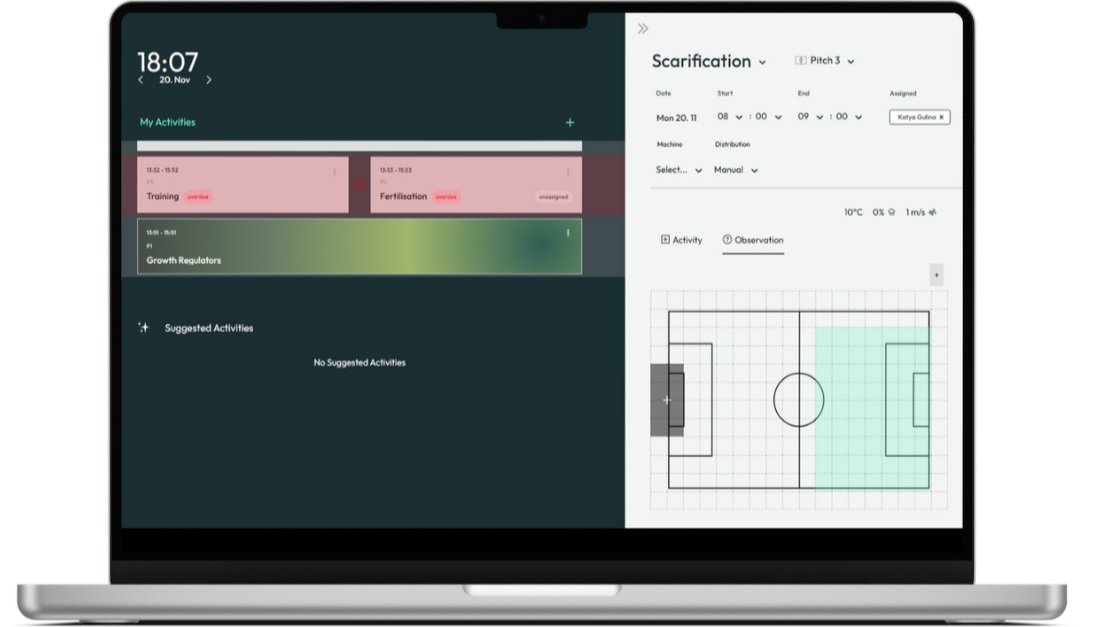How Does Data Drive Effective Turf Management?
For ardent sports enthusiasts, the lush, pristine playing surfaces where professional athletes showcase their talents may appear as mere backdrops to the excitement on the field. However, the truth is that this meticulously managed turf carries profound implications, impacting many stakeholders in ways that extend far beyond the confines of the playing field. From athletes to fans, teams to broadcasters, and sponsors to environmental advocates, the state of the turf plays a pivotal role in fulfilling the diverse objectives of the sports industry.
In light of our partnership with turfcoach, this article delves into the historical and present evolution of the groundskeeping and turf management industry, shedding light on the revolutionary impact of turfcoach's innovative solution that positions the company as a pioneer within the domain of turf data.
The German company’s software solution uses artificial intelligence and machine learning to provide automated data collection and data-driven insights on pitch quality and maintenance.
Let’s look at the granularities and reasons behind turf management. Which stakeholder needs the grass to be green on their side, and how can turfcoach’s solution help?
Turf Data to Improve Athletic Performance
The sports turf is their stage. Athletes exhibit their skills, endurance, and determination. Yet, the quality of this workplace can significantly impact the time they spend on the sidelines due to injuries. Older studies indicate that 24% of injuries can be correlated to the playing surface (Ekstrand & Gillquist, 1983) Moreover, over 90% of players perceive a link between the playing surface and injuries. More modern research confirms this hinge, showing that over 90% of muscle injuries and 51%–64% of joint and ligament injuries, such as ACL tears, in football occur in non-contact situations.
Unsurprisingly, the overall injury level for professional footballers is around 1000 times higher than for industrial occupations, generally regarded as high risk. Further, there is a gender bias as female footballers are two to eight times more likely to experience than males to suffer an ACL injury. (Source: http://dx.doi.org/10.1136/bjsm.33.3.196)
Academy players are critical assets of a club. More than 75 per cent of academy players have been injured at least once in their career, and nearly one in two survey respondents occasionally fear injury from the pitch.
And it’s not just that. Injured players are a big financial burden on the Club. The total cost to clubs in the top 5 European leagues due to injury & illness was €472.61m in 2020/21. The average cost due to injury & illness in each of top 5 European leagues was €94.52m in 2020/21.Howden, 2021 European Football Injury Index
These statistics emphasise the profound influence of maintaining a healthy playing surface on athletes' joint and lower limbs for their health and that of the club.
Consider the legendary Barcelona team led by Pep Guardiola from 2008 to 2012, known for their mesmerising style and flair on the pitch. While their tactical brilliance and individual skills are celebrated, a hidden aspect of their unparalleled performance lies in the quality of the playing surface. He even had the grounds managers come in at half-time to report on the pitch conditions and define how much watering was optimal. (https://www.uefa.com/insideuefa/about-uefa/news/025c-0f8e775cbd76-a467351b03e2-1000--mud-plastic-and-grass-the-evolution-of-the-football-pitch/).
Based on this, turf management as a concept has evolved. In the olden days, groundskeepers just cut the grass, mark it, and make it look as good as possible. However, nowadays, as exemplified by teams such as FC Barcelona’s Golden Era, groundskeepers have a more significant task on their hands to ensure they provide the optimum pitch for the type of football the team plays, carefully considering the pace of the pitch, the length of the grass & the amount of water it contains and ensuring that the players benefit from its quality by spending less time on the sidelines due to pitch-induced lower-limb injuries.
With advancements in new technologies, such as turfcoach’s solution, that could benefit coaches in implementing their unique brand of football, this “excellence” can be accessible to more and more clubs.
Recognising players as valuable assets, clubs must consider investing in top-notch turf maintenance to mitigate injury risks and optimise performance. A well-maintained pitch ensures consistent ball roll speed and bounce, crucial factors influencing the game's dynamics. By prioritising turf quality, clubs safeguard their players and create an environment conducive to skilful and strategic play. In this regard, turf management emerges as a strategic investment, contributing to the longevity of players' careers and elevating the overall standard of sports performance.
Beyond the Grass: The Commercial Benefits of Effective Turf Management
Clubs, leagues, and sports organisations recognise the broader benefits of a well-maintained turf. In contemporary football, turf management plays a crucial role in shaping the brand appeal of clubs, especially in multi-use stadiums hosting diverse events like concerts and NFL games in Europe. Moreover, one cannot be oblivious to the growth of the Women’s game. In 2022 alone, 15.8 Million new viewers tuned in to watch women’s football.
Consequently, pitch usage has doubled the number of in-stadium events, placing a greater need for optimal turf conditions, which certainly impacts the global show. Major European football clubs, including Tottenham Hotspurs, Real Madrid CF, and FC Barcelona, have substantially invested in renovating their stadiums to cater to multiple purposes.
The longevity of the grass becomes a defining factor, ensuring the venue maintains a pristine and attractive appearance across various activities for a sustained period. While managing a turf for multiple purposes can be resource-intensive, introducing "Predictive Intelligence Technologies" provides grounds managers with a complementary tool to reduce resource usage and improve quality. A well-maintained turf minimises the need for frequent replacements and underscores a commitment to sustainability and cost-effectiveness.
Beyond practical considerations, the visual appeal of a lush, resilient playing surface enhances the overall brand image, contributing to a positive and dynamic perception of the club or organisation. In this way, turf management becomes a strategic asset in fostering a versatile and enduring brand identity in the competitive landscape of modern sports and entertainment venues.
There is enormous stress on the grass; therefore, sports organisations miss the opportunity to stage more events and use their venues creatively, prioritising their teams (and rightly so) and missing out on additional revenue. From the League’s perspective, a healthy, pristine, and consistently well-maintained turf is essential to the League's commercial success. Broadcasters, too, revel in the beauty of a well-groomed surface.
turfcoach’s solution enhances a club's entertainment potential- maintaining a pristine turf, and ensuring high-quality visuals for broadcasts, a critical element in captivating and attracting viewers. With viewership comes advertising revenue, and a top-notch playing field enhances a broadcaster's appeal to advertisers keen to showcase their products to engage and retain audiences.
In essence, effective turf management justifies its potential of being a central pillar, beyond just turf management, of a sports organisation's commercial success.
turfcoach’s software solution
Sustainability, a Sports Organisation’s Imperative?
For groundskeepers, the convergence of persistent matchday schedules and the pressure to deliver a pristine playing surface within a tight timeframe proves to be a challenging predicament more often than not. Additionally, the right resources to carry out their duties effectively are sometimes few and far between. Between preparing pitches for fast-approaching match days and managing resources, two essential utilities, pesticide use and irrigation, are frequently deployed without the environmentally conscious precision needed, giving rise to pressing sustainability concerns within sports organisations.
However, the significance of effective turf management stretches far beyond matchday preparedness's immediate requirements. It is intrinsically linked to the holistic goals of sports organisations, making it an indispensable element in achieving their sustainability objectives. Unforeseen circumstances and occurrences may lead to budgets being exceeded for additional resources.
Sports organisations have the unique opportunity to lead by example as they have platforms followed by a large and diverse audience. By embracing eco-friendly turf management practices, they can serve as front-runners in ecological preservation and demonstrate their commitment to a sustainable future. This extends beyond the playing field and influences fans, sponsors, and the wider community. It sends a powerful message that the sports industry values the environment as much as it loves on-field and commercial success.
How Does Data Drive Effective Turf Management?
By delving into various studies and real-life examples from sports organisations, we gain insight into the vital role of turf management. It not only enhances sports performance but also contributes to sustainability efforts while increasing the entertainment value of a club.
Similar to other functional areas in different industries, adopting a data-driven approach proves invaluable in achieving business objectives. This approach allows for the analysis of trends and the prediction of occurrences that might otherwise be overlooked. This principle holds true for turfgrass management, where traditional methods often need to catch up in accounting for unforeseen circumstances, such as unexpected weather conditions requiring additional maintenance resources.
The key lies in anticipation. Data drives effective turf management by providing actionable insights and recommendations, facilitating efficient maintenance practices by groundskeepers. Turfcoach stands out as a turf data software company, offering more comprehensive benefits to sports organisations than just support for turf management practices. Leveraging innovative AI and machine learning technology, turfcoach's data models are continually refined to integrate weather forecasts, maintenance schedules, surface conditions, and performance data into a unified Artificial Intelligence platform for the entire organisation.
Curious to learn more about turfcoach? Explore how they support sports organisations in maximising their turf management efforts here.
LaSource is a sports consulting agency specializing in assisting startups and sports tech companies. We offer a range of services tailored to empower high-potential startups to effectively penetrate the European sports industry. From providing market knowledge and enhancing brand awareness to facilitating business development, our comprehensive approach equips startups with the tools needed to access key decision-makers in the field.
Learn more about our collaborations with sports tech companies






